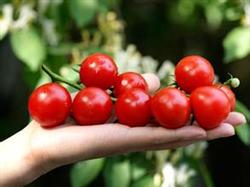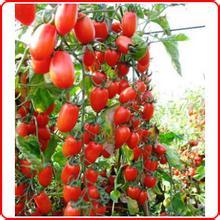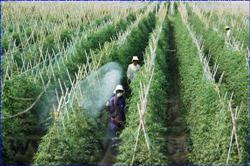Techniques of early planting of fresh virgin fruit in spring

Virgin tomato, native to Taiwan, is a kind of cherry tomato, mainly to eat fresh fruit, to be called virgin fruit. Early cultivation in spring, you can use a plastic greenhouse with a span of 6 meters, raise seedlings in the middle of November, plant in February of the following year, harvest fresh fruit in early May, and produce 6000 kg of fresh fruit per mu. First, seed treatment. In order to prevent the spread of seeds with bacteria, seeds should be disinfected before sowing. Seeds can be soaked in warm soup or medicament. Soaking the seeds in warm soup is to soak the seeds in cold water for 10 minutes, then put them in hot water of 50-55 ℃, stir them continuously and quickly, make the seeds heated evenly, add hot water at any time, stabilize the water temperature, remove the remaining heat in cold water after 15-20 minutes, and then soak in 25-30 ℃ warm water for 4-6 hours. Soak the seeds with gauze, soak the seeds in 10% trisodium phosphate solution for 20-30 minutes, then take out the seeds, wrap them in a wet towel and put them at 25-28 ℃ to promote germination. During the germination period, rinse the seeds with about 25 ℃ of warm water 1-2 times a day, accelerate germination for 2-3 days, and sow when 50% of the seeds are white. Second, sowing and raising seedlings. First water the prepared nursery bed, wait for the water to seep down for 2-3 hours, spread seeds evenly, and then cover 0.5-1 cm nutrient soil, the seed amount used in each square meter seedling bed is 3-5 grams, and the planting area per mu needs 8-10 square meters seedling bed. After sowing, cover the plastic film to keep warm and moisturize, and uncover the film immediately after emergence. The management of virgin fruit from sowing to unearthed cotyledons is mainly to create environmental conditions suitable for seed germination and emergence, so as to achieve the goal of full seedling, whole seedling and strong seedling as soon as possible. Third, transfer seedlings at the right time. When the virgin fruit has one leaf and one heart, transplant it to the nutrition bowl at noon on a sunny day. Nutrient soil is mainly composed of fully mature organic fertilizer, and appropriate increase of phosphorus fertilizer and appropriate application of nitrate fertilizer. In order to ensure adequate nutritional area, it is best to use a 9 cm × 9 cm nutrition bowl to protect the root system. The principle of seedbed management during virgin fruit seedlings is to have appropriate temperature, humidity and sufficient sunlight. It is realized by covering heat preservation, revealing film, watering and fertilizing, and expanding the distance between nutrition bowls. Fourth, planting. When the seedlings grow 7-8 true leaves (can be planted with buds). Double-row planting was carried out in each border, with small rows of 60 cm, plant spacing of 40 cm and 2000 plants per mu. The suitable planting depth is the flat border surface of cotyledon position, and the planting water should be poured thoroughly when planting. Cover with plastic film after planting. Cut the film according to the length of the border and the length of the soil at both ends, then put the cut film between the two rows of seedlings, then pull the film horizontally to the ridges and furrows on both sides, and finally tighten and compact. Field management, such as watering, topdressing, temperature management, uncovering greenhouse film, etc., is the same as conventional early cultivation of tomato in spring. Diseases and insect pests are relatively mild, but do not carry out control. Fifth, pruning. The virgin fruit grows rapidly in the greenhouse, and the plant is tall and upright. When the plant grows to 30-40 cm, it should be pulled by a stick or cable to prevent lodging. The growth of lateral branches is strong, and multi-layer plus continuous 2-layer coring pruning can be used, that is, keeping the inflorescence on the trunk, leaving the lateral branches on the trunk, leaving 2 inflorescences on each lateral branch, and then leaving 2 leaves on the inflorescence. It is necessary to branch and twist the opposite branches in time, so that the lateral branches do not block each other. Twisting branches are generally carried out on a sunny day, and the yellowing old and diseased leaves are removed in time, so as to reduce nutrient consumption and enhance light transmittance. Sixth, touch the flowers and protect the fruit. When the temperature is low in early spring, poor pollination can be used to smear the newly opened calyx and flower stalk (marked with red advertising color), or dip the more neat inflorescence in 2jing4murd solution. 7. Harvest. Because of the high sugar content of virgin fructose, only when it is fully ripe can it really reflect the inherent flavor and quality. Therefore, it should be harvested properly. Sepals and a stalk should be retained during harvest.
- Prev

Cultivation techniques of Virgin Fruit of small Tomato
1. In the northern part of the cultivation season, the seeds were sown from mid-September to early January of the following year, and harvested from the end of December to the middle of May of the following year; in the southern region, the seeds were sown from late August to mid-December and harvested from late November to April of the following year. Second, variety selection of disease resistance, heat resistance, high quality, high yield, resistance to storage and transportation, commerciality.
- Next

Several methods of seed treatment of Virgin Fruit
1. Aphids, also known as greasy insects and honey insects, are found all over the country. Groups gathered on the back of cherry tomato leaves and top tender stem heart leaves to prick and absorb juice, while secreting honeydew, affecting photosynthesis, making it serious 4, malnutrition, resulting in leaf shrinkage, leaf yellowing, difficult to grow normally. In addition, aphids can also.
Related
- Moge, come on! The staff of the peasant association in the producing area of cantaloupe were frightened when the crowd gathered.
- Causes and Solutions of low Fruit setting rate of Apple
- Symptoms and control measures of passion fruit virus disease
- Fruit growing lesson: how do apple orchards keep high yields?
- Can you build orchards in the mountains? What are the pros and cons?
- How to manage the coloring period of Crisson grape?
- This paper introduces the processing technology of two kinds of fig products.
- How much is a month for retired teachers in rural areas by 2020?
- How can strawberry planting increase sugar content? We should pay attention to management in many aspects.
- What are the cultivation techniques on how to improve the yield of golden fruit?

